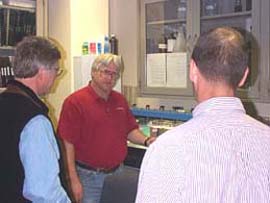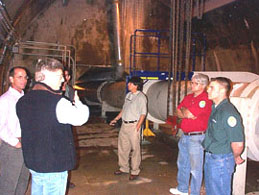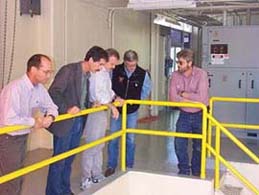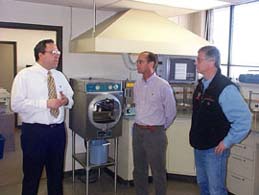Bulletin Board
Mayor Anderson Tours Water Facilities
April 10, 2000
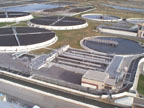
Mayor Ross C. “Rocky” Anderson spent Friday afternoon, April 7, touring Public Utilities water facilities. He and Rocky Fluhart, Chief Administrative Officer joined department employees to tour
the Parleys Water Treatment Plant and Little Dell Reservoir, as well as the Water Reclamation Plant.
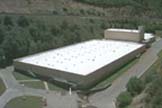
At the first stop, Victor Fernandez, plant manager, welcomed the Mayor and Fluhart to the Parleys Water Treatment Plant. Located 5-miles east of Salt Lake City in Parleys Canyon, the 45 million gallon per day conventional water treatment plant treats water stored in Little Dell and Mt. Dell reservoirs up-stream from the facility. Built in 1965 the treatment facility was upgraded and expanded in 1992. First thing on the tour was a demonstration of the treatment processes using the laboratory jar test procedure. The jar test simulates plant conditions. One-liter filled breakers of raw water are dosed with various treatment chemicals and then rapidly mixed. The speed is then reduced simulating the flocculation process. Dennis Potts, plant operator explained the process by saying, “The floc particles, resembling snowflakes, are gently stirred and grow in size and density. As the floc particles swirle about they gather up the impurities in the water. Then the water passes through the sedimentation basins and the floc and attached impurities settle out.” The settled material, called sludge, is removed by mechanical collectors.
|
|
The final processes are filtration and post chlorination. After the jar test demonstration, Potts pointed out the other laboratory tests that are performed by plant personnel.
Mayor Anderson and Rocky Fluhart watched a filter backwashed before reaching the chemical treatment portion of the treatment plant. John Allred, plant operator, spoke about the new sodium hyprochloride generator that uses common salt as the source chemical. Allred, with pride showed the new feed piping that he designed and the plant personnel constructed. “Hyprochloride is much safer than gaseous chlorine and cheaper too,” explained Allred “It cut down the chlorine smell in the plant.”
In the flocculation and sedimentation basins, there was an opportunity to see the mechanical equipment that does the work. One-half the plant was down for maintenance, and without water obscuring the equipment a clear view was possible. It was explained that the plant was divided in half in order to perform maintenance on one-half while keeping the other half in operation.
During the tour, Mayor Anderson asked a wide range of questions; such as information regarding the Crytosporidium outbreak in Milwaukee, chlorination, fluoridation and water problems in third world countries. The plant tour concluded by viewing the finished treated water in the clearwell. Victor Fernandez pointed out that the final water quality far exceeds federal drinking water standards. The Safe Drinking Water Act standard is 0.3 NTUs, but the goal is to keep it below 0.1 NTU. Fernandez noted that the plant average is 0.04 NTUs.
|
|
Mike Bertelsen, plant operator, led the tour through the DOCS Building and the pipe gallery. The 42-inch pipe that conveys the water diversions into the reservoir and then releases water back out of the reservoir for discharge into Mt. Dell Reservoir goes through a tunnel on the left abutment around the dam into the upstream side of the dam and the inlet structure. If one suffers from claustrophobia, the trek might be uncomfortable, but no one seemed to be bothered.
The last stop was Salt Lake City’s Water Reclamation Plant located at 1365 West 2300 North, Salt Lake City. The plant was put into operation in 1965. The 56 million gallon per day plant provides secondary level treatment with a permit limitation of 25 ppm TBOD and 25 ppm TSS. Jon Adams, Water Reclamation Manager, conducted the plant tour. Spreading over 130 acres, the treatment plant serves the sewer connections within the corporate limits of Salt Lake City. Besides the residential population, there are numerous industries that require discharge permits under the EPA required Pretreatment Program.
|
|
At the Pretreatment Plant, the raw sewage is screened and the grit separated before being pumped to the main plant. Looking into the pump chamber, you can’t help being impressed with the depth of the chamber and pumps. The original pumps are still in operation, however, Adams indicated that they need to be replaced. “The original pumps have been rebuilt so many times that the casings are paper thin and spring leaks,” said Adams. It is proposed to replace the two 250 hp and two 350 hp pumps with four 350 hp submersible pumps. According to Adams, “This will increase the plant’s total peak pumping capacity, even out the flow into the main treatment plant to avoid spikes, and most importantly, in the event that the pump chamber was flooded, the submergible pumps could continue to operate.”
|
|
As the tour continued around the main treatment plant, Adams explained the different treatment processes, beginning with the primary clarifiers, the digesters and methane gas flaring. Mayor Anderson asked questions about the digesters and the resulting methane gas and the proposed improvements to the secondary treatment processes. On top of the secondary pumping structure, the group had a panoramic view of the entire treatment plant. The trickling filters, solids/contact basin, secondary clarifiers and sludge beds were all within eyesight by turning 360 degrees. The next increment of organic treatment capacity will come from changing the media in one of the trickling filters. The change in media will provide 5,000 pounds per day of additional organic treatment capacity. Snails grow in the new media and it will be necessary to construct snail removal treatment.
The tour concluded by viewing the dried sludge, driving by the cogeneration building and stopping at the chlorine contact basin where the treated wastewater is discharged.
Mayor Anderson commented, "The treatment site looked more like a park than a treatment plant.” The lawns are irrigated with treated wastewater. The Mayor was interested in reuse of wastewater as a future water supply.
Public Utilities employees appreciated the Mayor and Rocky Fluhart taking the time to visit the various facilities to find out first hand what they are doing to provide quality services to their customers.
Questions regarding this article can be directed to: jon.adams@ci.slc.ut.us and victor.fernandez@ci.slc.ut.us
